The Flavors for Pharmaceutical & Healthcare Applications Market is estimated to be valued at USD 1.3 billion in 2025 and is projected to reach USD 2.3 billion by 2035, registering a compound annual growth rate (CAGR) of 5.5% over the forecast period.
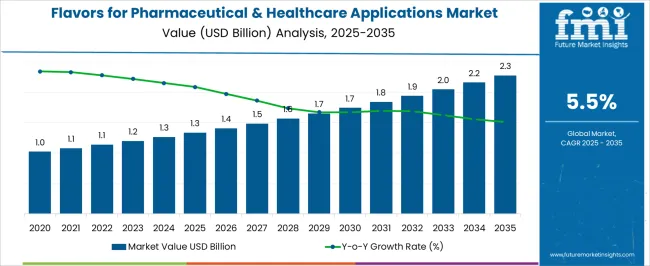
| Metric | Value |
|---|---|
| Flavors for Pharmaceutical & Healthcare Applications Market Estimated Value in (2025 E) | USD 1.3 billion |
| Flavors for Pharmaceutical & Healthcare Applications Market Forecast Value in (2035 F) | USD 2.3 billion |
| Forecast CAGR (2025 to 2035) | 5.5% |
The flavors market for pharmaceutical and healthcare applications is expanding steadily as patient centric formulations gain traction in both prescription and over the counter segments. The increasing need to improve palatability of oral dosage forms, especially among pediatric and geriatric populations, has been a key driver for flavor integration.
Innovations in taste masking technologies and the development of natural and allergen free flavoring agents are further supporting adoption across diverse therapeutic categories. Manufacturers are also leveraging flavor systems to enhance compliance and brand differentiation, particularly in chewable tablets, syrups, and lozenges.
Additionally, the shift toward personalized medicine and functional healthcare products has encouraged formulators to offer more sensory friendly drug delivery solutions. As the pharmaceutical industry continues to prioritize user experience and adherence, flavor systems are becoming a critical element in improving treatment effectiveness and consumer satisfaction.
The market is segmented by End Use and region. By End Use, the market is divided into OTC Drugs, Dietary Supplements, Therapeutic Nutrition, Healthcare Nutrition, Infant Nutrition, Sports Nutrition, Clinical Malnutrition, and Others. Regionally, the market is classified into North America, Latin America, Western Europe, Eastern Europe, Balkan & Baltic Countries, Russia & Belarus, Central Asia, East Asia, South Asia & Pacific, and the Middle East & Africa.
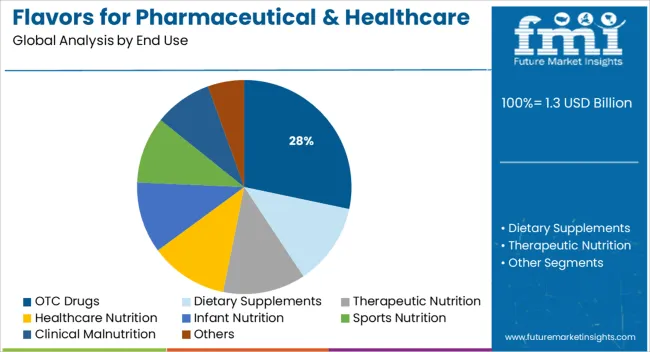
The over the counter drugs segment is projected to hold 28.30% of total market revenue by 2025, making it the dominant end use category. This is driven by the widespread availability of non prescription medications that rely on consumer preference and ease of administration.
Flavors are increasingly used in syrups, chewables, and dissolvable films to enhance taste and improve patient acceptance. The rise in self medication trends and growing awareness of preventive healthcare have further supported the use of appealing flavor profiles in OTC formulations.
Additionally, the competitive landscape within the OTC sector has led brands to invest in flavor innovation as a means of improving product differentiation and consumer retention. This focus on convenience, taste, and user satisfaction continues to reinforce the prominence of the OTC drugs segment in the flavors for pharmaceutical and healthcare applications market.
In the aftermath of the COVID-19 pandemic, customers were gaining wide acceptance for natural ingredients, boosting the usage of botanical extracts in foodstuffs, which was expected to significantly impact the product perspective over the historical period.
The adoption of nutritious food and a healthy lifestyle as a result of the coronavirus pandemic has contributed to the expansion of the flavors for the pharmaceutical and healthcare applications market with a CAGR of 4%. According to a survey conducted by Amway, a health and wellness expert, 9 out of 10 Thai adults are taking important steps to maintain their health following the COVID-19 outbreak, which is predicted to increase sales revenue in the coming decades.
The growing working-woman population and rising awareness about child nutritional requirements will drive flavor demand for infant nutrition compositions. Increasing clean label prerequisites are raising the significance of plant-based ingredients in pharmaceutical formulations, which is expected to expand market statistics during the forecast timeframe.
With the rising prevalence of age-related and lifestyle-related ailments, consumers are becoming increasingly aware of preventive healthcare initiatives and, as a result, are gravitating toward health-benefiting products such as food additives, which are expected to drive the global market. Increased innovation by both major and minor market players is fueling the global growth of the dietary supplement flavors market.
Multiple Governmental Initiatives and Rising participation in Sports are fueling Market Expansion
Various initiatives are being undertaken by regulatory agencies such as the Food and Drug Administration of the USA (USFDA) to guarantee that only high-quality food supplements are offered on the market, thereby encouraging customers to use dietary supplements. Moreover, the rising use of food nutritive additives is anticipated to increase consumer needs for healthcare product flavors in the coming years.
Another factor driving the market growth is people's strong interest in sports and bodybuilding. Athletes and sportspeople are becoming more engaged in sports nutrition products and supplements to strengthen their stamina and efficiency. The growing popularity of sports nutrition, vitamin, and performance-enhancing aspects will benefit the market in the coming years.
Greater Awareness of Artificial Flavoring may stifle Industry Development
Consumers’ awareness of the usage of artificial flavoring substances is expanding, which is restricting overall growth. Food processors have been obligated to include artificially curated flavors in their products due to rising food intake. Despite this, people's widespread perception that natural flavors are superior to artificial substances has stymied the growth of the flavors for the pharmaceutical and healthcare applications market.
Nevertheless, due to the increasing integration of natural-flavored products in company offerings, as well as the upsurge in health conditions, the adaptation of flavored pharmaceutical products is expected to aid industry players in combating this concern.
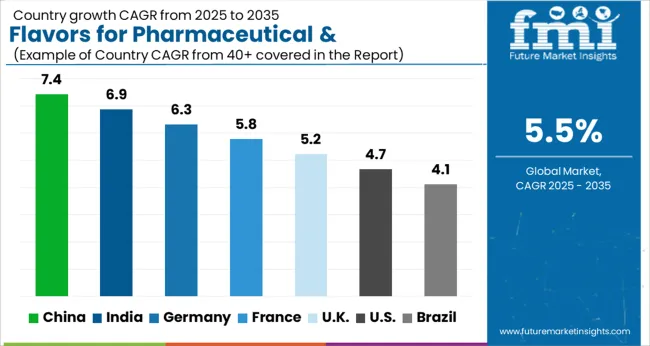
The popularity of flavored infant formula and nutrients to supplement children's food intake drives the market
From 2025 to 2035, the Asia Pacific flavors market for the pharmaceutical and healthcare industry is anticipated to rise at a CAGR of 5.7% CAGR. Flavors are widely used in dietary supplements, OTC drugs, therapy nutrition, and healthcare nutrition in the regional market, which is predicted to expand product penetration.
Furthermore, the high demand for flavored infant formula and nutrients to augment food intake among kids is increasing the deployment of various flavors in infant nutrition, which is expected to enhance the business strategy in the APAC region over the next several decades.
In addition, due to high population density, leading global market players are forecast to expand their desire to expand their industrial base and product offerings across Asian and Southeast Asian countries such as South Korea, Malaysia, India, China, and others.
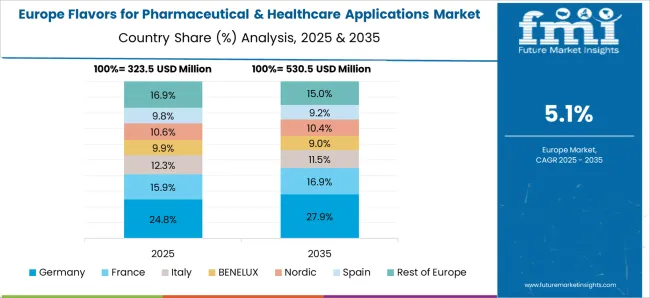
The aging population is propelling the market in Europe
The European healthcare product flavors market is expected to exceed USD 2.3 Million by 2035, with a CAGR of 5.2%. The aging population is one of the most visible social and demographic dynamics of the twenty-first century, particularly in European countries.
Between 2010 and 2060, the percentage of the population aged 65 and up is expected to nearly double, rising from 16% to 29% of the overall population of CEB (Council of Europe Development Bank) member countries, representing approximately 160 million individuals. As a result, the market's demand for adequate nutrients, drugs, and supplements increased as the population grew older. As a consequence, this factor should motivate regional market trends.
Changes in diet and living habits are promoting the expansion of the dietary supplement segment
The flavors for pharmaceutical and healthcare applications market from the dietary supplements end-use segment is expected to witness significant growth, with revenue exceeding USD 2.3 Million by 2035.
Dietary supplements, which can take the form of pills, capsules, tablets, powders, or liquids, enhance the human diet by providing nutrients harvested from food or synthetic sources to increase the quantity consumed.
Changes in eating habits and lifestyles are contributing to the emergence of several ailments, growing at a significant rate for dietary supplements because of their numerous health advantages, which is expected to drive market expansion.
Omega-3 fatty acids promote intellectual development and reduce Asthma Risks
The omega fatty acid segment is anticipated to expand at a CAGR of 7.1% through 2035. Omega fatty acids seem to become important tools in clinical science and have been shown to provide medical benefits for people of all ages, from infancy to old age. They are in high demand among consumers because they aid in intellectual growth and lower asthma risks.
Furthermore, the pharmaceutical industry creates, discovers, manufactures, and markets pharmaceutical drugs for use as medications to be administered to patients to cure or vaccinate them. Because baby boomers and millennials are largely concerned with product taste, automakers are embracing omega fatty acids in chewable capsules of various colors and flavors, establishing lucrative opportunities for the industry.
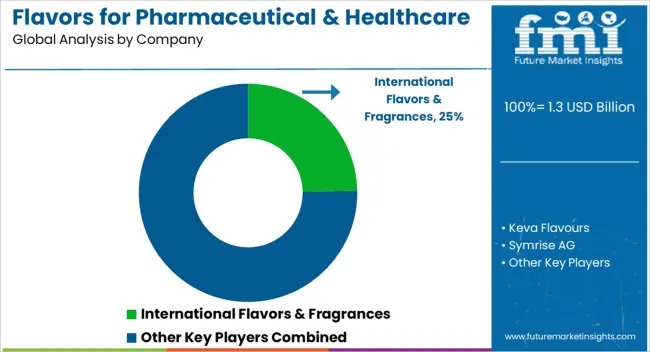
Keva Flavours, Gold Coast Ingredients, International Flavours & Fragrances (IFF), Symrise AG, Prinova Nagasa Group, Mane SA, Firmenich, Taste Master Flavors, Wild Flavors & Specialty Ingredients, Quest Nutra Pharma, Concept Flavors & Fragrances, Carmi Flavors & Fragrances, and Sapphire Flavors & Fragrances, among others are some of the major players in the flavors market for pharmaceutical & healthcare applications.
| Report Attribute | Details |
|---|---|
| Market Value in 2025 | USD 1.2 Billion |
| Market Value in 2035 | USD 2.05 Billion |
| Growth Rate | CAGR of 5.5% from 2025 to 2035 |
| Base Year for Estimation | 2025 |
| Historical Data | 2020 to 2024 |
| Forecast Period | 2025 to 2035 |
| Quantitative Units | Revenue in USD Billion and CAGR from 2025 to 2035 |
| Report Coverage | Revenue Forecast, Volume Forecast, Company Ranking, Competitive Landscape, Growth Factors, Trends, and Pricing Analysis |
| Segments Covered | End-user, Region |
| Regions Covered | North America; Latin America; Europe; Asia Pacific; Middle East & Africa |
| Key Countries Profiled | USA, Canada, Brazil, Mexico, Mexico, Germany, United Kingdom, France, Spain, Italy, India, China, Japan, South Korea, Australia, Saudi Arabia, South Africa, United Arab Emirates(UAE), Israel |
| Key Companies Profiled | International Flavors & Fragrances; Keva Flavours; Symrise AG; Mane SA; Prinova Nagase Group; Taste Master Flavours; Firmenich; Wild Flavors and Specialty Ingredients; Concept Flavors & Fragrances; Quest Nutra Pharma; Carmi Flavors & Fragrances; Gold Coast Ingredients; Sapphire Flavors & Fragrances |
| Customization | Available Upon Request |
The global flavors for pharmaceutical & healthcare applications market is estimated to be valued at USD 1.3 billion in 2025.
The market size for the flavors for pharmaceutical & healthcare applications market is projected to reach USD 2.3 billion by 2035.
The flavors for pharmaceutical & healthcare applications market is expected to grow at a 5.5% CAGR between 2025 and 2035.
The key product types in flavors for pharmaceutical & healthcare applications market are otc drugs, dietary supplements, _vitamins & minerals, _proteins & amino acids, _dietary fibers, _omega fatty acids, _botanicals, therapeutic nutrition, healthcare nutrition, infant nutrition, sports nutrition, clinical malnutrition and others.
In terms of , segment to command 0.0% share in the flavors for pharmaceutical & healthcare applications market in 2025.






Full Research Suite comprises of:
Market outlook & trends analysis
Interviews & case studies
Strategic recommendations
Vendor profiles & capabilities analysis
5-year forecasts
8 regions and 60+ country-level data splits
Market segment data splits
12 months of continuous data updates
DELIVERED AS:
PDF EXCEL ONLINE
Flavors and Fragrances Market Analysis by Type, Nature, Application, and Region through 2035
Feed Flavors Market Size and Share Forecast Outlook 2025 to 2035
Food Flavors Market Insights – Taste Innovation & Industry Expansion 2025 to 2035
Pork Flavors Market Analysis by Form, Packaging and Distribution Channel Through 2035
Beef Flavors Market Insights - Trends & Forecast 2025 to 2035
Bacon Flavors Market Size, Growth, and Forecast for 2025 to 2035
Dairy Flavors Market Trends - Growth & Industry Forecast 2025 to 2035
Global Umami Flavors Market Insights – Growth, Demand & Forecast 2025–2035
Turkey Flavors Market Trends Size & Forecast 2025 to 2035
Citrus Flavors Market Report – Trends & Innovations 2025 to 2035
Liquid Flavors Market Analysis – Demand, Growth & Forecast 2025-2035
Analysis and Growth Projections for Natural Flavors Business
Seafood Flavors Market Growth - Innovations & Industry Demand 2025 to 2035
Chicken Flavors Market
Cat Food Flavors Market
Botanical Flavors Market Size and Share Forecast Outlook 2025 to 2035
Alcoholic Flavors Market Size, Growth, and Forecast for 2025 to 2035
Chocolate Flavors Market Analysis by Product Type, and Application Through 2035
Clean Label Flavors Market Analysis by Liquid Systems, Spray-Dried Powders, Encapsulated Flavors, Emulsion-Based Delivery Systems Through 2035
Oil Soluble Flavors Market

Thank you!
You will receive an email from our Business Development Manager. Please be sure to check your SPAM/JUNK folder too.
Chat With
MaRIA